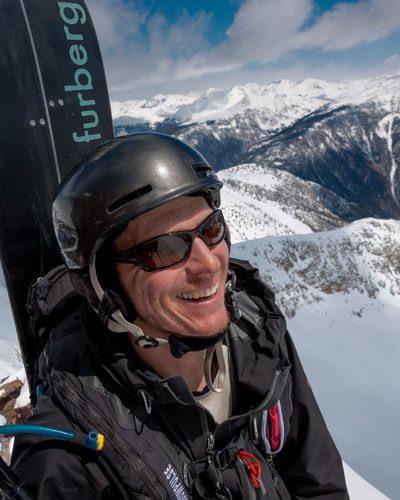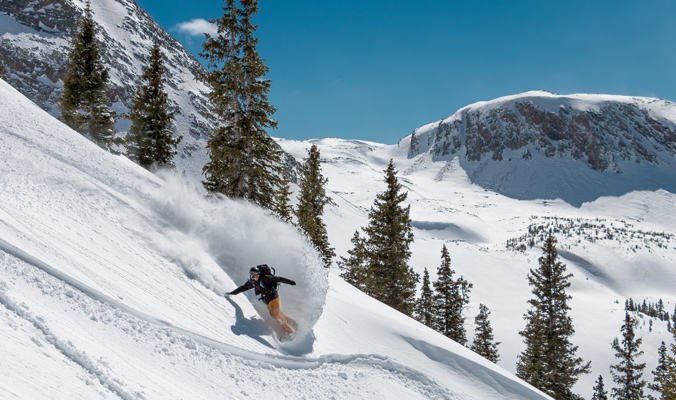As a splitboarder, I keep my ear to the ground when it comes to new gear that might make my life more enjoyable in the mountains. That’s why I was intrigued when Phantom Splitboard Bindings hit the market in 2012. These bindings, designed to be used with lightweight alpine touring ski boots, have quickly become a go-to for splitboard mountaineers around the world. In addition to Phantom providing a cool new product, its story is unusual. With a marketing plan based almost entirely on word-of-mouth sales, Phantom has successfully grown in the years since its founding. What’s even more interesting about this revolutionary company is that founder John Keffler is a full-time rocket scientist.
Keffler spends his days in the office as a thermal analyst designing complex systems for a rocket that NASA plans to use in the first manned mission to Mars. While many in the snow sports industry have dedicated their lives to backcountry pursuits, John was a relative late-comer, with his introduction to splitboarding in the winter of 2010.
His aptitude for the sport grew as quickly as word spread about his business. In his off hours, he went on splitboard mountaineering missions in his adopted state of Colorado, and quickly learned that if he was going to reach his objectives for mountain pursuits, he needed better tools.
It’s not every day that a rocket scientist decides to start manufacturing splitboard bindings, so I caught up with Keffler to learn more about his company and how he splits his time between space pursuits and splitboarding.

John Keffler “splits” his time between snowbaording and Rocket Science. [Photo] Zach Wilson
John Keffler: I’ve been working on the Orion program for almost ten years now as an embedded subcontractor working inside Lockheed, which is the prime contractor for this program. The Orion program is a spacecraft that is being designed to explore “deep space”. It looks similar to the Apollo spacecraft that took humans to the moon in the late ’60’s early ’70’s. This spacecraft is being designed such that it could explore the moon, an asteroid or Mars. I’m one of hundreds or even thousands of engineers working on this program and other various programs that support this spacecraft’s mission. I have a master’s degree in mechanical engineering with a specialization in heat transfer and fluid mechanics. I work as a thermal analyst with about 12 other thermal engineers and together we model the spacecraft to predict the vehicle’s temperature extremes from transport to the launch pad, launch, space flight, reentry, post landing and then transport back to the Kennedy Space Center. Those predictions are used by spacecraft component designers and by mission planning to ensure that the vehicle will survive all these various environments. The best part of my job is working with such brilliant and talented engineers.
AS: What is the most rewarding part of your day job?
JK: The most rewarding part of my day job has been getting to be in the middle of our first test launch in December 2014, and the build up of the test vehicle leading up to that point. It was really wild to find myself sitting at a console as a member of the launch team—what a thrill. For our next test flight, NASA will be doing most of the launch operations, which is usually how it works, but for that first test flight Lockheed was mainly running the mission.
AS: What was the inspiration for the Phantom Binding system?
JK: I’ve always had a love of the outdoors and enjoyed building things. My first year on a splitboard just happened to be one of the best snow years in Colorado in 30 years. My wife was working weekends and this was before we had kids. So needless to say, I got a lot of riding in and got totally hooked on splitboarding. I loved the adventure, being in the mountains, finding my own way, and of course, the riding was all-time. I also made connections with fellow splitboarders in the area through the forums on splitboard.com and got to ride a lot of cool terrain here in Colorado despite being so new to the sport.
However, that first year I broke nearly everything on my soft boot splitboard bindings, and I’m not really a big guy or very hard on my gear. It was also pretty easy to see that it was not a very efficient system or method when it came to touring. What really did it for me though was when the springtime hit and I started to explore the alpine and steep ascents and descents. I had my boot crampons come off a few times while on a steep climb and thought, “This is dangerous and dumb.” It also wasn’t hard being an engineer looking at the soft boot splitboard approach to realize that the gear was pretty antiquated. That may sound arrogant or demeaning to some, but that is not my intent. It’s just the facts from a technical standpoint.
That summer I set out to see if I could design a binding from the deck up, specifically for splitboarding in a plastic shell boot. The main objective was to make the whole system, boot and binding, work together to ride like I was used to [a traditional snowboard binding for the way down]. I didn’t have any intention of starting a splitboard company, I just wanted something better for myself.

Keffler enjoys a sunny day in the backcountry. [Photo] Zach Wilson
JK: Oh man it’s been a huge challenge. I never wanted to run a business because I knew it would be a ton of work, which it has been and still is. I’ve been working roughly 60-hour weeks for a few years now—lots of long nights and weekends trying to make it all work. The drive most certainly comes from splitboarding and not from any illusion of making money. My personal gear keeps getting lighter, stronger and easier to use. Once I’m happy with it, I then pass that along to the general public.
AS: Your bindings have become the standard in the industry with many world renown guides singing their praises. How have you taken such a niche within a niche and built a successful business?
JK: I’m not sure really. It baffles me, too, that something I made for myself turned into a world-wide movement. To be fair, the number of bindings sold so far is really small compared to other splitboard binding companies. However, when I look at who’s bought my bindings and is riding Phantoms, it makes me think I must be doing something right.
Guys like Joey Vosburgh, Mark Hartley, Barrows Worm de Geldern and many more who were piecing together a splitboard system for their plastic shell boots really helped to grease the skids.
I’m sure timing has a lot to do with it, too. In today’s digital-internet age, I am able to work with people all over the world to get design input and feedback. And of course, in today’s internet age, I have access to markets all over the world. I’m really bad at marketing, but thankfully people find me.
The other key is being able to buy a two buckle, lightweight ski boot. It wouldn’t mean much if I came up with a binding but the only boots were traditional heavy, stiff, four-buckle ski boots. These new two-buckle ski boots are pretty soft which is great for splitboarders.
I’d also like to think that part of the reason why Phantom has done so well is because I use and ride these bindings. They don’t exist because I want to sell people more stuff. Sounds odd coming from a business owner, but I’m not trying to sell something really. This is simply a means to an end for me.
—
Find out more about Phantom Splitboard Bindings at phantomsnow.com.










Related posts:
Boardroom: An interview with Pallas Snowboards co-founder Stephanie Nitsch
Boardroom: Franco Snowshapes gets quantum with snowboard design
Boardroom: an interview with Christine Feleki, aspiring female splitboard guide
Boardroom: From Mall Shop Manager to Snowboard Brand Owner, Mason Davey Follows His Own Path